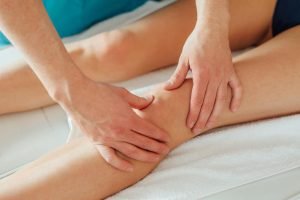Summary
One of the painful conditions affecting the bones and joints is bursitis. This is the inflammation of the bursae, small fluid-filled sacs found between bones, tendons, joints, and muscles. The human body has about 150 bursae, which help cushion and smooth the movement of joints.
Bursitis occurs when these bursae become inflamed, often due to repetitive motion of the affected area.
Symptoms of bursitis include pain, swelling, redness, tenderness, and difficulty moving the affected area.
Various treatments are available for bursitis, including compresses, ice application, and protecting the affected area. Anti-inflammatory medications like steroids, ibuprofen, and aspirin can also help reduce inflammation and relieve pain.
Table of Contents
Symptoms of Bursitis

Bursitis causes tenderness and pain in the affected areas. In this condition, the bursae may swell, leading to restricted movement. The following are common areas affected by bursitis:
- Shoulders
- Hips
- Elbows
- Knees
- Buttocks
- Waist
- Ankles
The symptoms of bursitis in these affected areas include:
- Tenderness. The affected area may feel sensitive to touch, even with slight pressure.
- Intense pain. Bursitis can cause significant pain, especially when moving or using the affected joint.
- Pain upon pressure or movement. Pain often intensifies when the area is pressed or engaged in movement, limiting the range of motion.
- Swelling and redness. The area may appear swollen, and the skin may look red due to inflammation.
- Difficulty lifting objects. Bursitis in certain joints, such as the shoulder, may make lifting objects challenging or painful.
These symptoms can make daily activities difficult, as movement and pressure on the affected joints exacerbate discomfort. Prompt management of bursitis can help relieve these symptoms and restore mobility in the affected area.
Types of Bursitiss
Bursitis can affect any part of the body where bursae are present. Here are the different types of this condition:
- Anterior Achilles Tendon Bursitis. Also known as “Albert’s disease,” this type of bursitis is caused by strain and injury to the tendons. It can also be triggered by wearing uncomfortable shoes. In this condition, the bursa located in front of the tendon attaching to the heel becomes inflamed.
- Posterior Achilles Tendon Bursitis. Known as “Haglund’s deformity,” this type of bursitis occurs between the skin of the heel and the Achilles tendon, which connects the calf muscles to the heel. It is aggravated by walking styles that put pressure on the soft tissue of the heel. This type of bursitis is commonly found in women.
- Hip Bursitis. Also called trochanteric bursitis, this condition typically results from injury, spinal abnormalities, arthritis, or surgery. It is more common in women and older adults. The bursa affected in this case is located on the outer part of the hip.
- Elbow Bursitis. This type is caused by the inflammation of the olecranon bursa between the skin and bones of the elbow. It can result from injury or continuous pressure on the elbows, often seen in individuals who frequently rest their elbows on hard surfaces.
- Knee Bursitis. Also referred to as “goosefoot bursitis” or “Pes Anserine bursitis,” this type affects the Pes Anserine bursa, located between the shinbone and the tendons of the inner thigh muscles. It may be caused by insufficient stretching before exercise or other activities that strain this part of the knee.
- Prepatellar Bursitis. Known as “housemaid’s knee,” this type of bursitis affects the bursa covering the front of the knee. It is common in individuals who frequently kneel, such as carpet layers, plumbers, or those in professions requiring prolonged pressure on the knees.
Each type of bursitis may require specific treatment approaches, depending on the location and cause. Rest, anti-inflammatory medications, and lifestyle adjustments can often help manage symptoms, while severe cases may require medical interventions like injections or physical therapy.
Diagnostic Procedures for Bursitis
Diagnosing bursitis involves several steps to determine the cause and extent of the inflammation. Here are the common diagnostic procedures for bursitis:
- Physical Examination. A doctor will typically start with a physical examination, checking for pain, tenderness, swelling, and warmth around the affected joint. They may also assess your range of motion to see how the condition affects joint mobility.
- Medical History Review. Understanding the patient’s medical history, including any repetitive movements, injuries, or underlying conditions like arthritis, helps the doctor identify potential risk factors for bursitis.
- Imaging Tests.
- X-rays are used to rule out other conditions, such as fractures or arthritis, as they don’t show bursae directly but can help assess joint health.
- Ultrasound is effective for visualizing soft tissues like bursae and can help identify inflammation.
- MRI may be used for a more detailed view of the soft tissues surrounding the joint if ultrasound results are inconclusive or if more information is needed.
- Aspiration of Bursal Fluid (Joint Aspiration). In some cases, the doctor may extract fluid from the swollen bursa using a needle. This procedure, known as aspiration, helps in two ways: it can reduce swelling and also allow the fluid to be analyzed for signs of infection or gout.
- Blood Tests. Blood tests may be ordered if an infection or an inflammatory condition (such as rheumatoid arthritis) is suspected as the cause of bursitis. Elevated levels of white blood cells or specific markers can indicate an inflammatory response.
- Laboratory Analysis of Bursal Fluid. If infection is suspected, the fluid taken from the bursa during aspiration may be sent to a lab to identify the presence of bacteria or other pathogens, aiding in selecting the right antibiotic treatment.
These diagnostic procedures enable healthcare providers to determine the cause, severity, and most appropriate treatment for bursitis. Early diagnosis and targeted intervention can help reduce pain, prevent complications, and restore joint function.
Complications of Untreated Bursitis
If left untreated, bursitis can lead to several complications, potentially worsening the condition and affecting overall joint health. Here are some potential risks of untreated bursitis:
- Chronic Pain and Discomfort. Without treatment, the inflammation in the bursae can persist, leading to ongoing pain that can interfere with daily activities and reduce quality of life.
- Limited Range of Motion. Persistent inflammation may cause the affected joint to stiffen, making it difficult to move and perform routine tasks. This reduced mobility can worsen over time if not addressed.
- Infection (Septic Bursitis). Untreated bursitis, especially in cases where bacteria are present, can lead to septic bursitis—a serious infection in the bursa. This condition requires prompt medical intervention, often including antibiotics or even drainage.
- Tendon and Muscle Damage. Ongoing inflammation and pressure on surrounding tissues can lead to damage of tendons and muscles around the affected joint, potentially resulting in long-term functional limitations.
- Joint Degeneration. In severe cases, untreated bursitis can contribute to joint wear and tear, accelerating joint degeneration and increasing the risk of arthritis or other joint disorders.
- Increased Risk of Recurrent Bursitis. Without proper management, bursitis can become a recurring condition, with flare-ups triggered by minor activities or movements, leading to a cycle of inflammation and pain.
To prevent these complications, early diagnosis and appropriate treatment of bursitis are essential. Treatment options like rest, medication, and physical therapy can help reduce inflammation, manage pain, and restore normal joint function.
Causes of Bursitis

Bursitis is commonly caused by repetitive movements of a specific body part or by injuries from sports activities. Other factors that may lead to bursitis include:
- Poor posture. Incorrect posture can place undue strain on certain joints, increasing the risk of bursae inflammation.
- Improper walking mechanics. Walking with an incorrect gait can lead to misalignment, causing pressure on the joints and soft tissues, which may trigger bursitis.
- Compression of soft tissues due to poor joint positioning. When joints are misaligned, the surrounding soft tissues, including the bursae, may get compressed, leading to inflammation.
- Other types of arthritis. Conditions like rheumatoid arthritis, osteoarthritis, and gout increase the likelihood of bursitis due to joint inflammation, which can extend to the bursae.
- Metabolic conditions such as diabetes. People with metabolic disorders are more susceptible to inflammatory conditions, including bursitis, due to systemic changes in the body’s response to stress and inflammation.
- Side effects of certain medications. Some medications may increase the risk of bursitis by affecting the body’s inflammatory response or the structural integrity of soft tissues.
Pain from bursitis is usually localized near the joints, making it easy to mistake for other conditions like arthritis or rheumatism. Proper diagnosis is essential to distinguish bursitis from these similar joint-related disorders.
Prevention of Bursitis

Preventing bursitis involves adopting healthy practices and taking steps to protect your joints from unnecessary strain. Here are some effective strategies to help prevent bursitis:
- Maintain proper posture. Ensuring correct posture during daily activities helps reduce excess pressure on your joints and minimizes the risk of bursae inflammation.
- Use protective gear. When engaging in activities that put pressure on your joints, such as kneeling or lifting, use protective padding or braces to safeguard the bursae.
- Take breaks during repetitive activities. Allowing your body to rest from tasks involving repetitive motions helps prevent overuse injuries and reduces the likelihood of bursitis.
- Stretch and warm up before exercise. Preparing your body before engaging in physical activities reduces the strain on your joints and lowers the risk of bursae inflammation.
- Maintain a healthy weight. Excess body weight increases the pressure on your joints, potentially leading to bursitis. Keeping your weight within a healthy range helps alleviate this risk.
By maintaining a healthy lifestyle, practicing good body mechanics, and using proper techniques in activities, you can significantly reduce the chances of developing bursitis.
Risk Factors for Bursitis

The following factors increase the likelihood of developing bursitis:
- Age. Studies indicate that bursitis becomes more common as people age, likely due to cumulative joint wear and tear over time.
- Type of occupation or hobby. Jobs or hobbies that involve repetitive movements or actions that put pressure on the bursae increase the risk of bursitis. Examples include playing musical instruments, painting, and gardening, which require repetitive motions that can strain the joints.
- Medical conditions. Certain health conditions, such as arthritis, gout, diabetes, and obesity, can contribute to the development of bursitis. These conditions may increase inflammation or place additional stress on the joints, heightening the risk of bursae inflammation.
Managing these risk factors, when possible, can help reduce the likelihood of developing bursitis. For those with high-risk occupations or hobbies, taking regular breaks and using proper techniques may help prevent joint strain and bursae inflammation.
Bursitis FAQs
Here are some frequently asked questions about bursitis to provide a better understanding of this condition:
- What causes bursitis?
Bursitis is often caused by repetitive motions or prolonged pressure on a specific joint, but it can also be triggered by injuries, poor posture, or certain medical conditions like arthritis, gout, or diabetes. - Who is at risk for developing bursitis?
People at higher risk include those over the age of 40, individuals with occupations or hobbies that involve repetitive motions (like musicians, athletes, or gardeners), and those with medical conditions that increase joint stress or inflammation. - Can bursitis be prevented?
Yes, bursitis can often be prevented by taking steps like using protective gear, strengthening surrounding muscles, warming up before exercise, maintaining a healthy weight, and taking breaks during repetitive tasks. - What are the symptoms of bursitis?
Common symptoms include pain, tenderness, swelling, redness, and limited range of motion in the affected joint. The pain often worsens with movement or pressure on the area. - How is bursitis diagnosed?
A doctor typically diagnoses bursitis through a physical examination and a review of symptoms. Imaging tests like X-rays, ultrasounds, or MRIs may be used to rule out other conditions and confirm bursitis. - What are common treatments for bursitis?
Treatment usually includes rest, ice application, anti-inflammatory medications, and physical therapy. In severe cases, a doctor may recommend corticosteroid injections or even surgery if the bursitis is persistent. - Can bursitis heal on its own?
Mild cases of bursitis may improve with rest and home care. However, more severe cases often require medical intervention to prevent the condition from worsening. - Is bursitis the same as arthritis?
No, bursitis and arthritis are different. Bursitis is the inflammation of the bursae, while arthritis refers to inflammation within the joints themselves. However, arthritis can increase the risk of developing bursitis. - Can exercise worsen bursitis?
Some types of exercise, especially those involving repetitive joint movement, can worsen bursitis if done without proper form or preparation. Low-impact exercises and proper warm-ups are usually safer and may even help prevent bursitis. - When should I see a doctor for bursitis?
It’s best to consult a doctor if the pain doesn’t improve with rest, if swelling and redness are severe, if there is a fever (which could indicate infection), or if the symptoms significantly impact daily activities.


